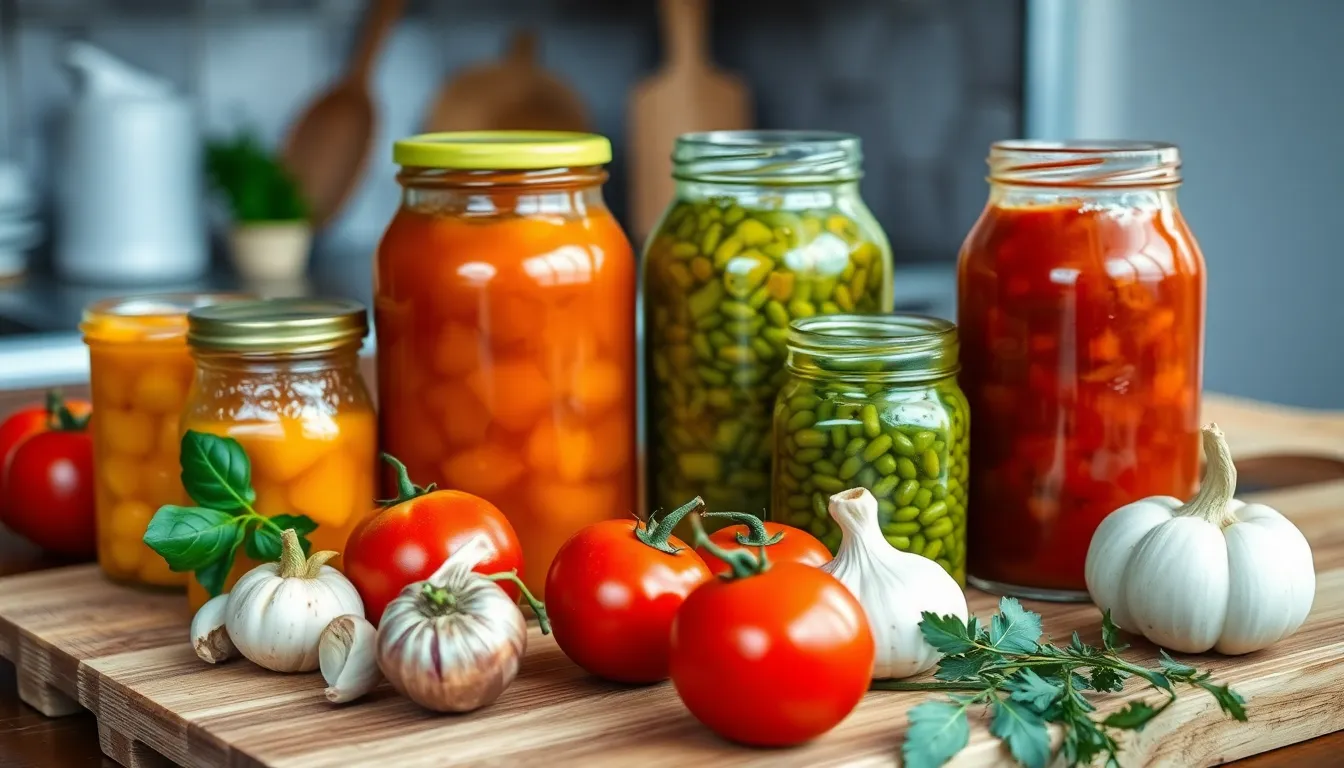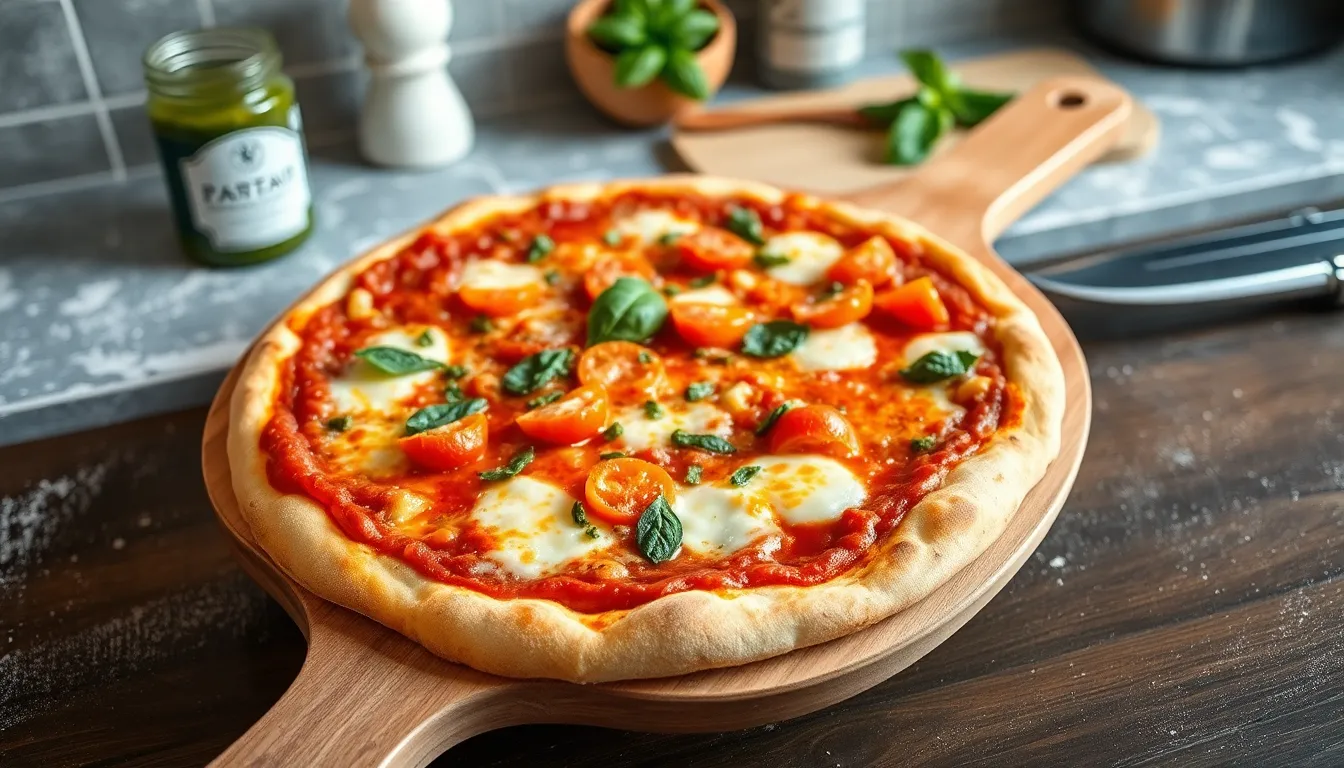Table of Contents
TogglePicture this: you’re craving pizza but your fridge is looking a little bare. Suddenly, you spot that half-full jar of pasta sauce lurking in the back. Can it work? The answer might just surprise you.
Using pasta sauce on pizza isn’t just a creative hack; it’s a culinary adventure waiting to happen. While traditional pizza sauce has its charm, pasta sauce can bring a unique twist to your favorite pie. Imagine the rich flavors of herbs and tomatoes mingling with gooey cheese and crispy crust.
Overview of Pasta Sauce and Pizza Sauce
Pasta sauce and pizza sauce serve distinct roles in cooking, yet they share common ingredients. Traditional pasta sauce often includes tomatoes, garlic, onions, and herbs, resulting in a rich and flavorful base. Conversely, pizza sauce usually has a smoother texture and can be seasoned with spices like oregano and basil.
Pasta sauce can vary significantly based on regional recipes, with variations including marinara, Alfredo, and pesto. Additionally, these sauces may contain vegetables, meats, or cheeses, contributing to a complex flavor profile. On the other hand, pizza sauce focuses on a less complex combination of flavors, offering a concentrated tomato taste that’s easily spread across a pizza crust.
Both sauces can complement cheese and toppings effectively, but their uses differ. When using pasta sauce on pizza, one can create a unique flavor experience that enhances the overall dish. Texture plays a crucial role here; chunky pasta sauces may not stick as well to the crust as a traditional pizza sauce.
Storage and preparation are also worth mentioning. Pasta sauce typically comes in jars, ready for quick use. Pizza sauce, however, often requires a simple blend of canned tomatoes and seasonings for a fresh taste.
Cooks often find themselves improvising in the kitchen. Using pasta sauce for pizza may require some adjustments, like reducing excess liquid or enhancing seasoning to achieve the desired flavor. Ultimately, both sauces exhibit versatility that encourages experimentation and creativity in meal preparation.
What Is Pasta Sauce?

Pasta sauce refers to a flavorful condiment commonly paired with pasta dishes. It offers a range of tastes and textures, enhancing meals with its rich ingredients.
Ingredients Typically Found in Pasta Sauce
Tomatoes serve as the primary base in most pasta sauces. Garlic adds depth to the flavor profile, bringing aromatic notes. Olive oil contributes richness, while herbs like basil and oregano provide freshness. Additionally, some recipes include onion or bell pepper for a sweeter taste. Parmesan cheese often rounds out the mix, imparting a savory quality. These ingredients combine to create diverse and satisfying flavors ideal for elevating pasta dishes.
Common Varieties of Pasta Sauce
Marinara stands out as a popular choice, featuring a simple tomato and herb base. Alfredo, on the other hand, offers a creamy texture derived from butter and cheese. Pesto showcases fresh basil combined with nuts and olive oil, delivering a vibrant flavor. Bolognese, a meat-based sauce, incorporates ground meat and vegetables for heartiness. Arrabbiata provides a spicy kick from red pepper flakes, catering to those who enjoy heat. Each variety offers a unique experience, expanding the culinary possibilities for pasta dishes.
What Is Pizza Sauce?
Pizza sauce serves as the primary condiment for pizza, specifically designed to enhance the crust and toppings. It features a smoother, thicker texture compared to pasta sauce, offering a concentrated tomato flavor that creates a balanced base.
Differences Between Pasta Sauce and Pizza Sauce
Pasta sauce and pizza sauce differ significantly in texture and flavor profiles. While pasta sauce often presents a richer, more complex consistency, pizza sauce focuses on a smoother texture. Ingredients in pasta sauce can include cream or cheese, adding depth. Contrarily, pizza sauce typically highlights the simplicity of tomatoes with minimal additional elements, which allows for easier spreading on pizza crusts. Additionally, pasta sauces come in various forms, such as marinara and Bolognese, whereas pizza sauce remains more consistent in flavor across recipes.
Key Ingredients in Pizza Sauce
Key ingredients compose pizza sauce, beginning with crushed tomatoes or tomato paste, which serve as the foundation. Garlic contributes aromatic depth, while herbs like oregano and basil enhance flavor profiles. Some recipes incorporate olive oil for richness, balancing the acidity of the tomatoes. Sugar occasionally makes an appearance, offsetting any bitter notes from the tomatoes. Other additions may include onion powder or chili flakes, introducing subtle variations and complexity to this essential pizza topping.
Can I Use Pasta Sauce for Pizza?
Using pasta sauce for pizza offers a creative alternative for those looking to experiment with flavors. While pasta sauce and pizza sauce share similarities, their unique characteristics can lead to exciting culinary results.
Pros of Using Pasta Sauce for Pizza
Pasta sauce brings rich flavors to pizza, enhancing the overall taste experience. Variations like marinara or Alfredo can contribute unique twists, elevating standard pizza options. Texture varies across pasta sauces, allowing for experimentation, such as a creamier base with Alfredo. Ingredients like garlic and herbs often enhance the flavor profile, resulting in a more robust taste. Combining pasta sauce with quality cheese and fresh toppings can yield satisfying results, making it a viable option when traditional pizza sauce isn’t available.
Cons of Using Pasta Sauce for Pizza
Pasta sauce often contains excess liquid, which could lead to a soggy crust. Adjustments, such as reducing moisture, are sometimes necessary for optimal results. The complexity of pasta sauce may overshadow the pizza’s toppings, shifting focus away from other flavors. A few varieties, like pesto, may not pair well with typical pizza ingredients. The thick consistency of some pasta sauces also complicates spreading, making it more challenging to achieve an even layer on the crust.
Tips for Using Pasta Sauce on Pizza
Using pasta sauce on pizza offers a chance to explore unique flavor combinations. With the right approach, it can create a delightful culinary experience.
Enhancing Flavor
To enhance flavor, consider adding fresh herbs like basil or oregano. Incorporating spices such as red pepper flakes can introduce a pleasing heat. Adjusting seasoning by adding salt or pepper results in a balanced taste. Reducing excess liquid from the sauce ensures the crust remains crispy. Using garlic powder or grated parmesan brings depth to the dish. Layering cheese, toppings, and sauce creatively creates a harmonious mix of flavors.
Best Types of Pasta Sauce for Pizza
Certain pasta sauces work better for pizza than others. Marinara serves as a classic choice, offering a simple tomato flavor. Alfredo brings richness, pairing nicely with chicken and vegetables. Pesto adds a vibrant twist, complementing toppings like sun-dried tomatoes or artichokes. Arrabbiata provides spice, catering to those who enjoy heat. Bolognese maintains a complex flavor profile, ideal for hearty pizzas. Each sauce introduces distinct tastes, encouraging creativity in pizza-making.
Using pasta sauce for pizza can open up a world of flavor possibilities. While it may not replace traditional pizza sauce entirely, it offers a chance to experiment and elevate the pizza experience. With careful adjustments and the right type of pasta sauce, such as marinara or Alfredo, anyone can create a delicious pie that surprises the palate.
It’s essential to keep in mind the differences in texture and flavor intensity between the two sauces. By being mindful of these factors and making necessary tweaks, home cooks can enjoy a unique twist on their favorite dish. So next time there’s no pizza sauce on hand, don’t hesitate to reach for that jar of pasta sauce and unleash your culinary creativity.




